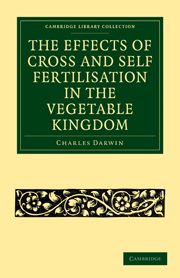Book contents
- Frontmatter
- Contents
- CHAPTER I INTRODUCTORY REMARKS
- CHAPTER II CONVOLVULACEÆ
- CHAPTER III SCROPHULARIACEÆ, GESNERIACEÆ, LABIATÆ, ETC
- IV CRUCIFERÆ, PAPAVERACEÆ, RESEDACEÆ, ETC
- CHAPTER V GERANIACEÆ, LEGUMINOSÆ, ONAGRACEÆ, ETC
- CHAPTER VI SOLANACEÆ PRIMULACEÆ, POLYGONEÆ, ETC
- CHAPTER VII SUMMARY OF THE HEIGHTS AND WEIGHTS OF THE CROSSED AND SELF-FERTILISED PLANTS
- CHAPTER VIII DIFFERENCE BETWEEN CROSSED AND SELF-FERTILISED PLANTS IN CONSTITUTIONAL VIGOUR AND IN OTHER RESPECTS
- CHAPTER IX THE EFFECTS OF CROSS-FERTILISATION AND SELF-FERTILISATION ON THE PRODUCTION OF SEEDS
- CHAPTER X MEANS OF FERTILISATION
- CHAPTER XI THE HABITS OF INSECTS IN RELATION TO THE FERTILISATION OF FLOWERS
- CHAPTER XII GENERAL RESULTS
- INDEX
CHAPTER VI - SOLANACEÆ PRIMULACEÆ, POLYGONEÆ, ETC
Published online by Cambridge University Press: 29 August 2010
- Frontmatter
- Contents
- CHAPTER I INTRODUCTORY REMARKS
- CHAPTER II CONVOLVULACEÆ
- CHAPTER III SCROPHULARIACEÆ, GESNERIACEÆ, LABIATÆ, ETC
- IV CRUCIFERÆ, PAPAVERACEÆ, RESEDACEÆ, ETC
- CHAPTER V GERANIACEÆ, LEGUMINOSÆ, ONAGRACEÆ, ETC
- CHAPTER VI SOLANACEÆ PRIMULACEÆ, POLYGONEÆ, ETC
- CHAPTER VII SUMMARY OF THE HEIGHTS AND WEIGHTS OF THE CROSSED AND SELF-FERTILISED PLANTS
- CHAPTER VIII DIFFERENCE BETWEEN CROSSED AND SELF-FERTILISED PLANTS IN CONSTITUTIONAL VIGOUR AND IN OTHER RESPECTS
- CHAPTER IX THE EFFECTS OF CROSS-FERTILISATION AND SELF-FERTILISATION ON THE PRODUCTION OF SEEDS
- CHAPTER X MEANS OF FERTILISATION
- CHAPTER XI THE HABITS OF INSECTS IN RELATION TO THE FERTILISATION OF FLOWERS
- CHAPTER XII GENERAL RESULTS
- INDEX
Summary
SOLANACEÆ.—Petunia violacea.
Dingy purple variety.
The flowers of this plant are so seldom visited, during the day by insects in this country, that I have never seen an instance; but my gardener, on whom I can rely, once saw some humblebees at work. Mr. Meehan says, that in the United States bees bore through the corolla for the nectar, and adds that their “fertilisation is carried on by night-moths.”
In France M. Naudin, after castrating a large number of flowers whilst in bud, left them exposed to the visits of insects, and abotit a quarter produced capsules; but I am convinced that a much larger proportion of flowers in my garden are crossfertilised by insects, for protected flowers with their own pollen placed on the stigma never yielded nearly a full complement of seed; whilst those left uncovered produced fine capsiiles, showing that pollen from other plants must have been brought to them, probably by moths. Plants growing vigorously and flowering in pots in the green-house, never yielded a single capsule; and this may be attributed, at least in chief part, to the exclusion of moths.
Six flowers on a plant covered by a net were crossed with pollen from a distinct plant and produced six capsules, containing by weight 4.44 grains of seed. Six other flowers were fertilised with their own pollen and produced only three capsules, containing only 1.49 grains weight of seed.
- Type
- Chapter
- Information
- Publisher: Cambridge University PressPrint publication year: 2009First published in: 1876



